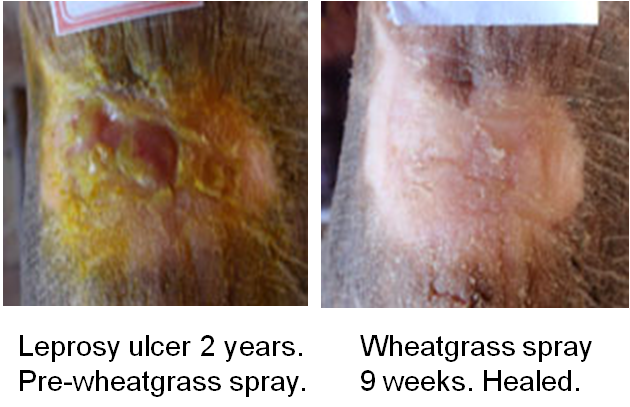A mission to India
Arriving in Mumbai from Australia the day after a major terrorist attack there left me feeling a little uneasy. After all, I had only come to India to see leprosy patients whose leg ulcers were being treated with wheatgrass extract. Some reports had been encouraging.
We had already tested the extract on a patient with a leprous ulcer on the sole of his foot. Because it healed after just three months, we decided to proceed with a pilot study of 20 patients. Some of the results we achieved were quite remarkable.
For example, an ulcer of 2 years duration (Figures 1 and 2) healed completely after just 9 weeks' wheatgrass treatment.
About leprosy and the ulcer study
Leprosy is still considered by some to be due to sinful behaviour - a myth that has bedevilled and isolated these patients for several thousand years. (See Leprosy in India. Wikipedia) Associated stigma often leads to rejection by family, friends, employers and the community as a whole.
The disease is not actually transmitted via skin contact, but from the sufferer's nasal droplets. Clearly, healing their ulcers might eliminate some of the stigmata associated with the disease.
Leprosy is caused by a mycobacterium which affects mainly nerves, skin and mucous membranes. Sufferers tend to lose sensation and motor ability. Sensory loss is often patchy and predominantly affects the hands and feet. Because affected skin is anaesthetised, or "deadened", the patient is unaware if it has been injured or not. Therefore, an ulcer may easily develop that may last the patient’s lifetime. In time, major deformities can develop leaving no choice but to amputate the affected foot or leg.
Our Project Co-ordinator for the Leprosy Pilot Study in Indore, Dr. Laxminarayan Vardharajan Ph.D., aka “Rajan”, (see pic below) had spent 30 years working in close contact with leprosy patients. He shared their suffering and treated their ulcers, always with bare hands which helped reduce the common belief that leprosy spreads directly by skin contact.
This is one of the cases treated with wheatgrass extract that healed after just 9 weeks.

About leprosy treatment
Surgery, such as skin grafting, can help to some extent, but so far, there is no medical treatment available that can eliminate the disease or heal the wounds of leprosy. Treatment is usually directed to hygienic care of the wound and application of prosthetics when required.
But wheatgrass shows promise as was revealed by the results of our clinical study.
One very important thing we learned was that over-treatment with wheatgrass extract tended to prolong the healing process. In retrospect, had we applied the extract once or twice a month, our results would almost certainly have been more successful.
